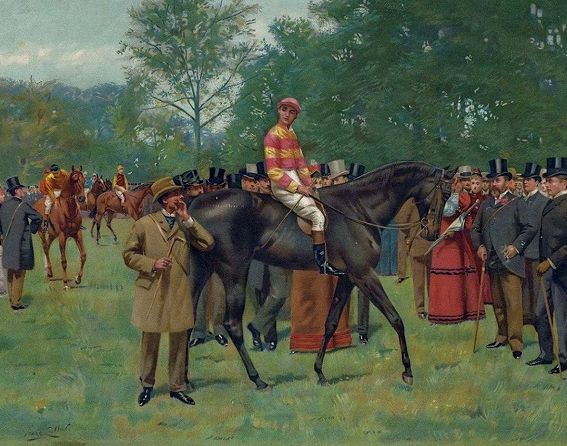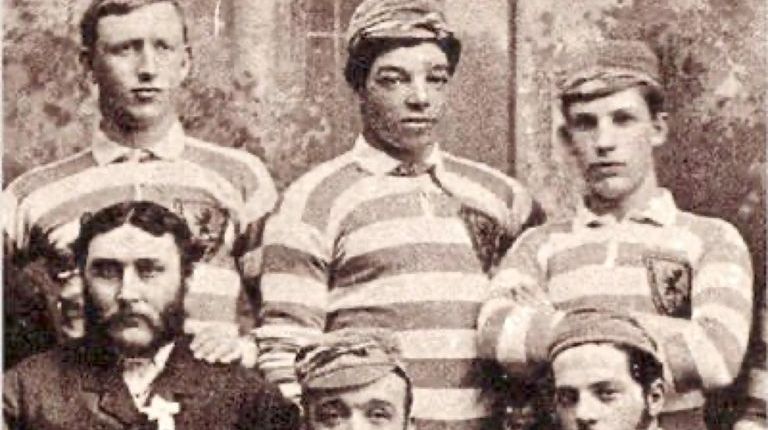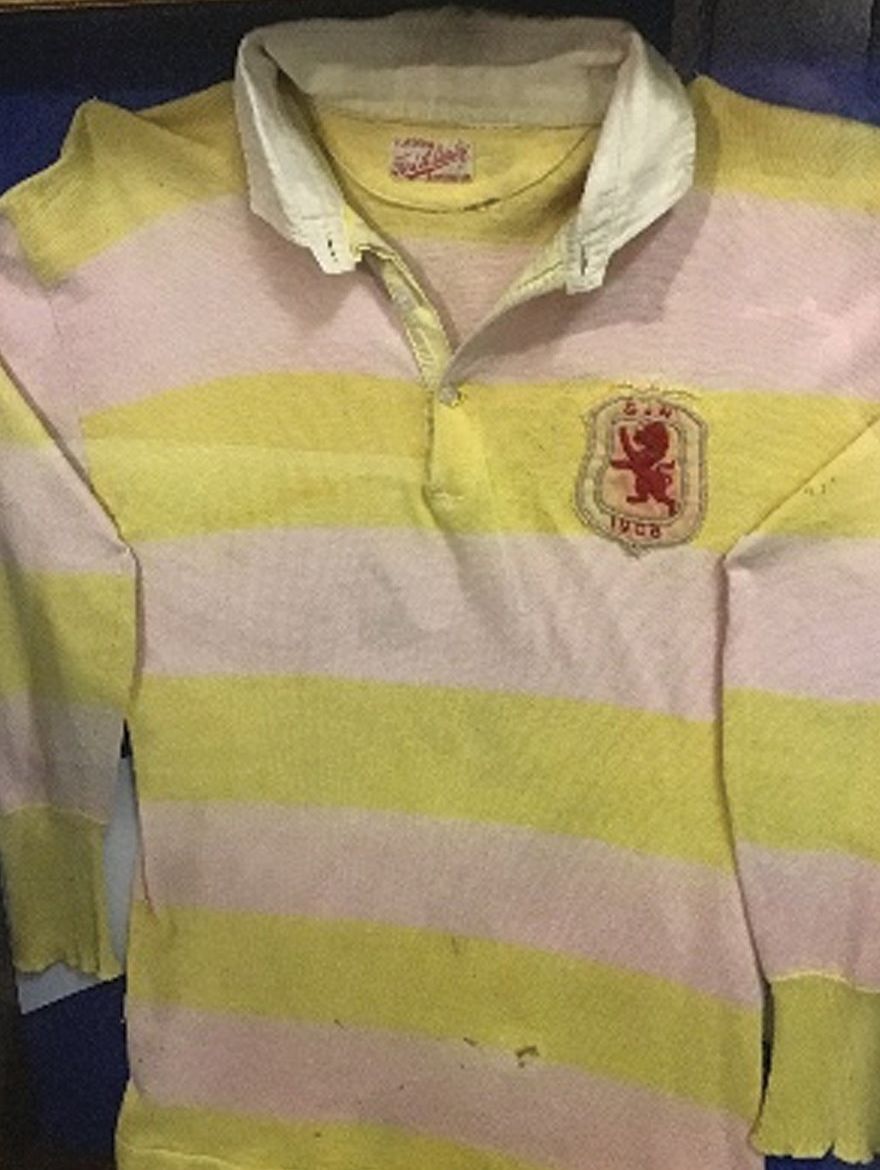
THE
ROSEBERY
COLOURS
THIS story behind Scotland wearing what are known as the Rosebery colours arose due to the global pandemic. Reduced opportunities to leave the house meant that I finally began to tidy up my programme collection. One of these was in poor condition (Scotland v England 1984) and upon delivery of a better copy purchased online, browsing through this, I was interested to read an article, supposedly from an SFA book entitled “One Hundred Years of Scottish Football”, in which was the following paragraph:
“There were 60,000 at the Rosebery international in Celtic Park in 1900. The Scotland team wore the primrose and pink racing colours of Lord Rosebery, the Hon President of the SFA. His horse Lada had won the Derby the previous year and Scotland marked the win and the new century by beating England 4-1.”
I immediately thought that this contains either a misprint or is a misquote of the book – you see, the streets in the area of Belfast in which I now live are named after Derby winners, and the one parallel to the street I live in is called ‘Ladas Drive’. To clarify this, the first stop was to look at the list of Derby winners – Ladas won the Derby in 1894 and “his career attracted an unusual amount of attention as his owner, Lord Rosebery, became PM of the UK at the height of his success” (sothe date of the Derby win in the article is also incorrect). In fact, in 1895, whilst PM, another of Rosebery’s horses, Sir Visto won the Derby (and also Cicero in 1905, which is another street in the area). There is a picture of Ladas and the jockey in the racing colours with the 5th Earl of Rosebery on the far right illustrated above.
So the Rosebery colours were worn due to the Hon President of the SFA, who had in fact also been the Prime Minister before this role and before the 1900 match? Further research into the man and the family was fascinating – Archibald Philip Primrose (1847-1929), was the 5th Earl of Rosebery, 1st Earl of Midlothian, the lineage going back to Archibald Primrose, 1st Earl of Rosebery (1664- 1723). As a young man he apparently boasted that he would marry the richest woman in England, become Prime Minister and own a Derby winner; he succeeded in all three. The 5th Earl of Rosebery was a wealthy man, and his fortune increased hugely when he married Hannah de Rothschild, who had inherited her family fortune in 1874 and became the richest woman in Britain. Upon the death of the 6th Earl of Rosebery, the de Rothschild ancestral home was sold, and the family have since been settled in the Primrose family home on the Dalmeny estate, in what became Midlothian.
He entered the cabinet in 1885 and served twice as foreign minister, paying special attention to French and German affairs. He succeeded Gladstone as Prime Minister and leader of the Liberal Party in 1894, but the Liberals lost the 1895 election, and he resigned the party leadership in 1896 and never again held political office.
But what is the connection to the Scottish National football team and colours? The Earl of Rosebery’s horse-racing colours (registered with the Jockey Club in 1868), are often inaccurately described - they are primrose and rose which are puns derived from the family name, which is Primrose, and the title which is Rosebery. The 5th Earl of Rosebery developed a keen in interest in association football and was an early patron of the Scottish FA, although the family are not quite sure how he got involved in football governance. In 1882 he donated a trophy, the Rosebery Charity Cup, to be competed for by clubs under the jurisdiction of the East of Scotland FA. The competition lasted over 60 years and raised thousands of pounds for charities in the Edinburgh area. This trophy now resides in the museum at Hampden.
Moreover he became the Hon. President of the SFA and of Hearts F.C and his colours were worn on 9 occasions between 1881 and 1951, and in 1900 when Scotland defeated England 4-1 (at least that is correct in the original article), he apparently told the Scotland captain Jacky Robertson, “I have never seen my colours so well sported since Ladas won the Derby.” Queen’s Park’s Robert S. McColl (who went on to set up a chain of sweet shops, earning the nickname ’Toffee Bob’) scored a hat-trick.
However, it is the first time that the Rosebery colours were worn in March 1881 that has a huge significance in Scottish football history. They were worn that day at the Oval cricket ground, and Scotland’s 6-1 win over England still remains England’s heaviest home defeat. More importantly, it marked the debut of Andrew Watson, who was possibly also captain for the day – the world’s first black international footballer. He is pictured here in 1881 wearing the Rosebery colours. The story of his life and his influence on the Scottish and international game can never be told enough and I would recommend that those who have not heard of him do some research into his life.
The badges on the strips have also been subject to change throughout history. In 1900, the Scottish thistle was worn, and against England in 1901 this was embroidered next to the English rose, and it is possible that other national emblems were added in the games against Wales and Ireland. The lion rampant crest worn for most of this period had the initials of the teams involved at the top of the crest and the year printed below the lion.
The colours were used most recently for the 2014-2015 away kit, and were also used for a Hearts away kit in 2016-2017. The Scotland kit with the top is depicted in the background – this was hardly an attractive kit and not popular, despite the tenuous link to the Rosebery colours.
It is strange that his support and involvement with the SFA would enable a change of the jersey colours for the team – however, as an early patron of the game, his colours may have been used in acknowledgement of his support (perhaps sponsorship) of the game, or were perhaps just in tribute to someone who was at the time something of a celebrity: immense crowds attended his daughter’s wedding, with thousands wearing primrose as a gesture to the family name and that day’s London Evening News was printed on primrose paper. A complete change of a national team’s home jersey colour is highly unusual and I cannot imagine that this would happen now (although who would rule out as long as the money was right, and that would be another nail in the coffin of international football).
During research into this article, I discovered that a long standing Scotland supporter and collector of memorabilia, Sandy Riddoch, has an original Rosebery jersey of Willie Lennie of Aberdeen, who played, and scored, in a 2-1 win v Wales in March 1908. This story about this jersey could fill another article, and it is pictured here with his kind permission – he thinks that there are further examples in the Scottish Football Museum.
The 5th Earl of Rosebery died in 1929, is the richest British PM that has ever lived, and is buried in Dalmeny. The family home at Dalmeny House is open to the public and contains an incredible range of artefacts, as would be expected from a marriage of members of the Primrose and de Rothschild families, and is open to the public.
How bizarre that living in Belfast and seeing an article in a programme from 36 years ago would lead to researching the fascinating life of the man behind the occasional colours of the national football team, and it can now be definitively stated that the colours are primrose and rose. Any errors in this article are entirely my own, and I am happy to be corrected.
Back to Articles

